June 2012
In June 2012 I was interviewed by Solid line Media, about working with camera stabilizers, for one of their blog postings. Iím re-posting the contents here with some additional footnotes. The original can be found here with some additional insights from Solid line Director of Photogrpahy Ed Boe. Iíve worked several times with Solid Line as a Steadicam Operator in recent years on corporate video projects.
Solid Line: Do you have a favorite steadicam system you like to use?
CARL: For the shoot on Monday I was using a Steadicam Flyer LE (Tiffen brand). With the lower capacity rigs (for cameras under 25 pounds) the Tiffen gear is probably the best as their quality control of vital components is very rigorous. There are many competing rigs in this arena that sell for a lower price, but there are typically drawbacks that accompany the lower cost, primarily in the variety and convenience of balancing adjustments (a paucity of which can make a rig unusable in a professional environment), as well as the range and precision of camera motion available (which affects the quality and variety of shots attainable). Steadicams also vary widely in terms of power and video distribution options, which again affects their applicability to professional shoots.
Solid Line: Whatís it like on the body? Do you have to break periodically?
CARL: Working with a larger rig (like the the full sized EFP rig I used on the June 14 shoot) both lower back muscle and cardio fatigue becomes a factor. With a larger rig itís best if I take short recovery breaks every five or ten minutes. On July 9 I was using the smaller Flyer rig which is much lighter and enables longer periods of shooting. I prefer using this rig for corporate and documentary shoots as they may require longer blocks of near continuous shooting. The drawback of the smaller Flyer rig is the limitation on accessories that can be added to the camera.* The great benefit for corporate shoots is being able to gather more footage by deferring the recovery breaks that a big rig requires.
Solid Line: And finally, why use a Steadicam at all? What does it add to the overall quality of a production?
CARL: The Steadicam is a great means of adding camera movement, either subtle or elaborate, to a production without excessive set up time.Ü Tracking shots of a location, product, or performer can help to engage a viewer. For instance a Steadicam walk-and-talk of two people discussing a location or product (while walking amongst the location/product) is frequently more interesting than a montage of tripod-bound shots with narration. Another benefit of Steadicam in a corporate video situation is the ability to spontaneously adjust the camera position in relation to any improvisations, or otherwise unexpected actions, by the talent or background elements.
* An additional contrast between working with larger and smaller rigs is that a bigger rig, with itís larger mass, is more stable and easier to control than a smaller rig. With that ease of control comes the trade off of inevitable muscle fatigue which can become a distraction on more intensive shooting days (depending upon the operators level of conditioning relative to the bulk of the camera being flown).
Ü I will add here that I am far from a Steadicam zealot and think that the best device for a shot should be utilized whenever possible. For instance a dolly or tracks are generally preferable for slow and precise camera moves or long lens work. However every production situation is not ideal and a steadicam will often be recruited for applications for which it is not best suited: for me itís usually doing tight close ups of products with a bit of camera movement or the inevitable production time-saver: becoming a Human Tripod.
Below are some further ruminations on the benefits and drawbacks of working with a full size rig vs. a smaller Steadicam. This was originally written as a reply to an operator who was contemplating selling his Pilot rig (camera capacity of 10 pounds) after he acquired a full size Steadicam Clipper (with a load capacity of 35 pounds). All remarks in this discussion regarding the Pilot apply equally to the Flyer LE, which is currently my primary small rig.
December 2010
... the Clipper may work better for smaller cameras than the EFP, which has a limited arm range and a bulkier base, so it may be better suited for a range of cameras and enable flexible set ups. For me having the lighter weight rig as an option or choice has been great after only having the EFP.
With the Pilot I can shoot one hour rock shows and thirty minute dance performances with an HVX200 and not require a break. I can work a twelve hour Indian wedding with a Canon 7D and feel no soreness at the end of the day. I've been able to meander through very tight, crowded spaces that are nearly impossible with a full size rig. I can do long corporate shoots or repeated takes with amateur talent (requiring extra takes) and not get sweaty or irritated. I recently worked on a comedic shoot (with repeated takes to improve nuances of performance) and was able to keep up the pace and have as much fun as everyone else on set. We shot some material outside and light winds were an issue, but keeping up with the pace of the shoot and maintaining a light demeanor was more important on the shoot than getting dolly like moves. My choreography and framing were great, but the horizon wobbled a bit in the wind. But the client and crew were all very pleased with the results. Sometimes when a budget is low and the day is short and I know I can get good results with the Pilot I'm more excited to do the job when I know I'm going to have a much easier and faster load in and set up (which also pleases the client) with the smaller rig. I'm still using the EFP rig for most exterior shoots however. The Pilot does becomes difficult to control with wind gusts. I also the like the big rig for dramatic shoots for which I need the highest level of precision control and prefer to have the rig loaded up with about 25 pounds of camera weight. This is fine for narrative style film shoots where there are breaks for re-lighting and make-up and I'm not expected (and there's no benefit) in wearing the rig for more than 10 minutes at a stretch. At this point I'm thinking about getting a Zephyr* (when released) to work with mid-weight set ups and have more power options, but not need to haul around fifty pounds on my spine to work with a 15 to 20 pound camera. As much a the extra ballast is good for inertia I have a more fun being super nimble and being able to relentlessly try different angles and blocking.
*I ended up acquiring a FlyerLE rig in late 2011 after learning that this last generation of the Flyer possessed many the elements that made the Zephyr appealing for smaller camera situations.
|
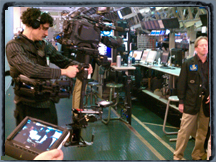
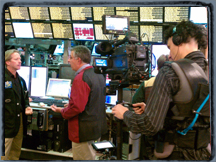
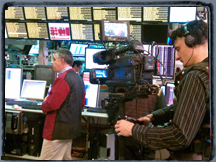

Working with the full size Steadicam EFP rig and shoulder mount style Sony XDCAM 350. Shooting with Solid Line Media at the Chicago Board Options Exchange in 2010.
 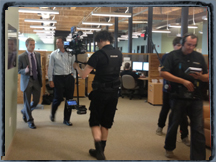
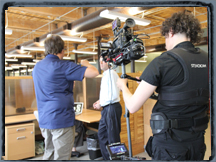 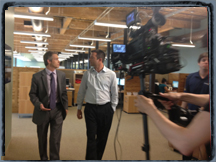
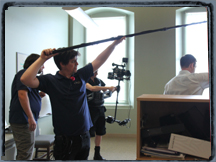
Working with the light weight Steadicam Flyer LE rig and the Sony F3. Shooting with Solid Line Media at Qvidianís offices in Lowell, Massachusetts in 2012.
|

